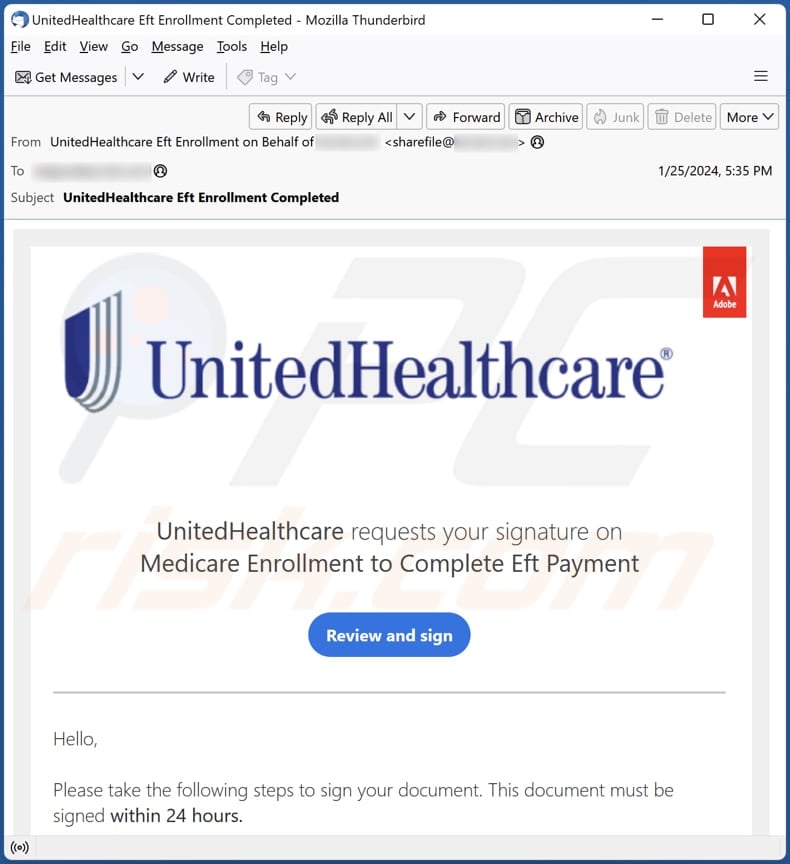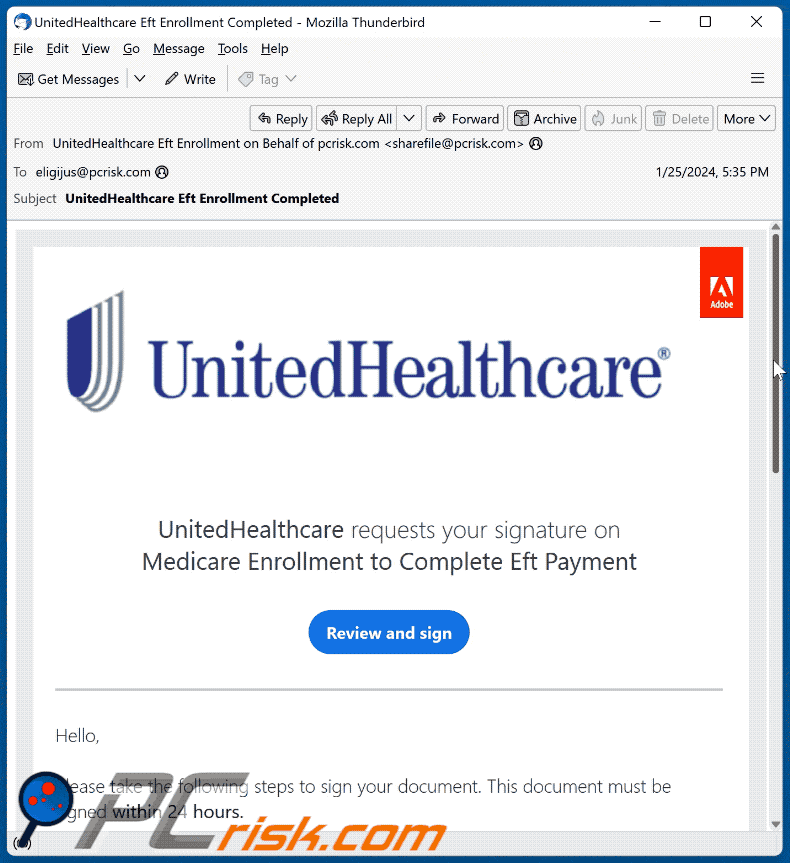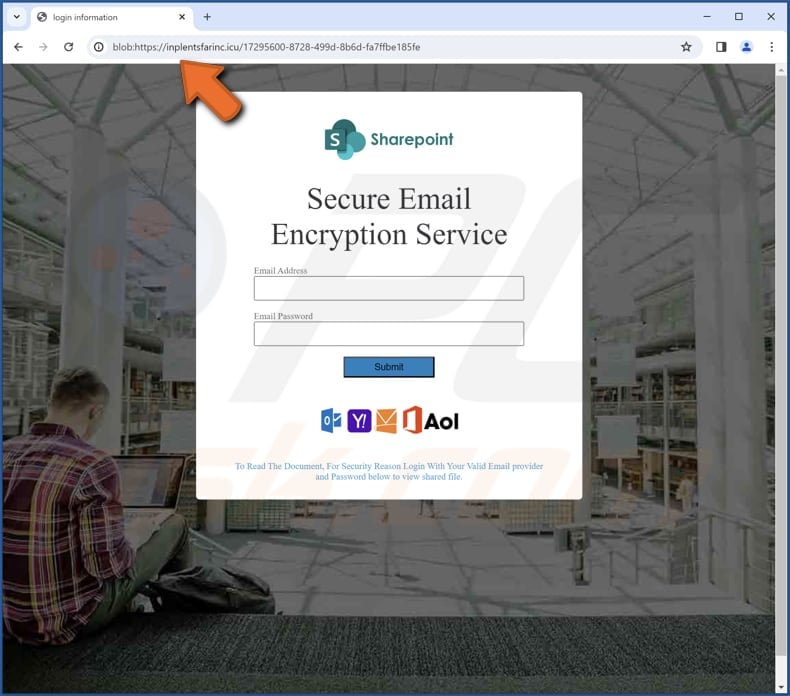How to identify fraudulent emails like "UnitedHealthcare"
Phishing/ScamAlso Known As: UnitedHealthcare phishing campaign
Get free scan and check if your device is infected.
Remove it nowTo use full-featured product, you have to purchase a license for Combo Cleaner. Seven days free trial available. Combo Cleaner is owned and operated by RCS LT, the parent company of PCRisk.com.
What kind of scam is "UnitedHealthcare"?
We examined the email and found that it is crafted to extract personal information from victims. Such emails fall into the category of phishing emails, often camouflaged as communications from reputable companies, organizations, or entities in an attempt to deceive recipients. Such emails should be ignored.

More about the "UnitedHealthcare" scam email
This phishing email, purportedly from UnitedHealthcare and adorned with the Adobe UnitedHealthcare branding, falsely claims that the recipient's Electronic Funds Transfer (EFT) enrollment has been completed. In order to create a sense of urgency, the email stipulates that the document must be signed within 24 hours.
The recipient is instructed to click on a "Review and sign" button, enter an access code provided by their supposed agent, review the document, and sign it promptly. The inclusion of contact details for an agent named Donald Gloria, with a Gmail address instead of a corporate domain, adds an element of purported legitimacy.
Additionally, a warning about an impending expiration time further pressures the recipient to act swiftly. Upon clicking the "Review and sign" button, a fraudulent Sharepoint login form emerges, featuring deceptive fields prompting the entry of an email address and password.
After individuals input their details into the fraudulent form, the scammers can gather this information to gain unauthorized entry into email and possibly other accounts. With access to the victim's email account, scammers can monitor and potentially misuse personal communications and sensitive data.
Also, scammers may use stolen email accounts to deceive the account holder's contacts. This can involve sending phishing emails, spreading malware, or engaging in fraudulent activities while posing as the legitimate account owner, exploiting the trust of the victim's contacts for further malicious purposes.
Additionally, the harvested credentials might be exploited to access other online accounts if the victim uses the same login credentials across multiple platforms.
| Name | UnitedHealthcare Email Scam |
| Threat Type | Phishing, Scam, Social Engineering, Fraud |
| Fake Claim | The recipient's Electronic Funds Transfer (EFT) enrollment has been completed. |
| Related Domain | inplentsfarinc[.]icu |
| Detection Names (inplentsfarinc[.]icu) | alphaMountain.ai (Suspicious), CyRadar (Malicious), Webroot (Malicious), Full List Of Detections (VirusTotal) |
| Disguise | Notification from UnitedHealthcare |
| Symptoms | Unauthorized online purchases, changed online account passwords, identity theft, illegal access of the computer. |
| Distribution methods | Deceptive emails, rogue online pop-up ads, search engine poisoning techniques, misspelled domains. |
| Damage | Loss of sensitive private information, monetary loss, identity theft. |
| Malware Removal (Windows) |
To eliminate possible malware infections, scan your computer with legitimate antivirus software. Our security researchers recommend using Combo Cleaner. Download Combo CleanerTo use full-featured product, you have to purchase a license for Combo Cleaner. 7 days free trial available. Combo Cleaner is owned and operated by RCS LT, the parent company of PCRisk.com. |
Similar scam emails in general
As a rule, emails of this type employ urgency or fear, creating a sense of immediate action. Also, they mimic trusted entities, such as reputable companies or institutions, using logos and branding to appear legitimate.
Phishing emails often contain clickable links or attachments that lead to fake websites or malicious content, aiming to extract sensitive information, like login credentials or financial details, or deliver malware.
Examples of similar emails are "KYC (Know Your Customer) Verification", "Unclaimed Expensive Goods", and "Account(s) Lost IMAP/POP3 Coverage".
How do spam campaigns infect computers?
Users can unwittingly infect computers via email by clicking on malicious links or opening infected attachments within emails. These links (opened pages) or attachments can contain malware, such as ransomware or viruses.
Emails used to deliver malware often include malicious attachments such as executable files (.exe), PDF files (.pdf), Microsoft Office documents (.doc, .xls), JavaScript files (.js), or compressed files (.zip) containing malware.
How to avoid installation of malware?
Exercise caution when interacting with emails, avoiding clicking links or opening attachments from unknown or unexpected addresses (especially when emails are irrelevant or unexpected). Regularly update and patch software, operating systems, and antivirus programs to ensure the latest security measures are in place.
Avoid visiting suspicious websites and only download software from reputable sources (official sites and app stores). Additionally, do not click pop-ups, ads, and similar content presented on/by shady pages. If you have already opened malicious attachments, we recommend running a scan with Combo Cleaner Antivirus for Windows to automatically eliminate infiltrated malware.
Appearance of the "UnitedHealthcare" scam email (GIF):

Text presented in the "UnitedHealthcare" email letter:
Subject: UnitedHealthcare Eft Enrollment Completed
Adobe UnitedHealthcareUnitedHealthcare requests your signature on
Medicare Enrollment to Complete Eft Payment
Review and sign
Hello,
Please take the following steps to sign your document. This document must be signed within 24 hours.
Action Required:
1. Click the 'Review and sign' button above
2. Authenticate by entering the Access Code provided by your agent
3.Review the entire document
4. Click the signature boxes to sign the document
5. Click the 'Click to Sign' button to submitQuestions?
If you have any questions, please contact your agent:
Agent Name: Donald Gloria
Agent Email: Donaldgloria6@gmail.com
Agent Phone Number: 4692145223Expiration Pending: If you are submitting an application less than 24 hours from the effective date, you must sign before 11:59PM CST.
Powered by Adobe SignBy proceeding, you agree that this agreement may be signed using electronic or handwritten signatures.
To ensure that you continue receiving our emails, please add adobesign@adobesign.com to your address book or safe list.
© 2021 Adobe. All rights reserved.
Screenshot of the phishing page used in this campaign:

Instant automatic malware removal:
Manual threat removal might be a lengthy and complicated process that requires advanced IT skills. Combo Cleaner is a professional automatic malware removal tool that is recommended to get rid of malware. Download it by clicking the button below:
DOWNLOAD Combo CleanerBy downloading any software listed on this website you agree to our Privacy Policy and Terms of Use. To use full-featured product, you have to purchase a license for Combo Cleaner. 7 days free trial available. Combo Cleaner is owned and operated by RCS LT, the parent company of PCRisk.com.
Quick menu:
- What is UnitedHealthcare phishing campaign?
- Types of malicious emails.
- How to spot a malicious email?
- What to do if you fell for an email scam?
Types of malicious emails:
![]() Phishing Emails
Phishing Emails
Most commonly, cybercriminals use deceptive emails to trick Internet users into giving away their sensitive private information, for example, login information for various online services, email accounts, or online banking information.
Such attacks are called phishing. In a phishing attack, cybercriminals usually send an email message with some popular service logo (for example, Microsoft, DHL, Amazon, Netflix), create urgency (wrong shipping address, expired password, etc.), and place a link which they hope their potential victims will click on.
After clicking the link presented in such email message, victims are redirected to a fake website that looks identical or extremely similar to the original one. Victims are then asked to enter their password, credit card details, or some other information that gets stolen by cybercriminals.
![]() Emails with Malicious Attachments
Emails with Malicious Attachments
Another popular attack vector is email spam with malicious attachments that infect users' computers with malware. Malicious attachments usually carry trojans that are capable of stealing passwords, banking information, and other sensitive information.
In such attacks, cybercriminals' main goal is to trick their potential victims into opening an infected email attachment. To achieve this goal, email messages usually talk about recently received invoices, faxes, or voice messages.
If a potential victim falls for the lure and opens the attachment, their computers get infected, and cybercriminals can collect a lot of sensitive information.
While it's a more complicated method to steal personal information (spam filters and antivirus programs usually detect such attempts), if successful, cybercriminals can get a much wider array of data and can collect information for a long period of time.
![]() Sextortion Emails
Sextortion Emails
This is a type of phishing. In this case, users receive an email claiming that a cybercriminal could access the webcam of the potential victim and has a video recording of one's masturbation.
To get rid of the video, victims are asked to pay a ransom (usually using Bitcoin or another cryptocurrency). Nevertheless, all of these claims are false - users who receive such emails should ignore and delete them.
How to spot a malicious email?
While cyber criminals try to make their lure emails look trustworthy, here are some things that you should look for when trying to spot a phishing email:
- Check the sender's ("from") email address: Hover your mouse over the "from" address and check if it's legitimate. For example, if you received an email from Microsoft, be sure to check if the email address is @microsoft.com and not something suspicious like @m1crosoft.com, @microsfot.com, @account-security-noreply.com, etc.
- Check for generic greetings: If the greeting in the email is "Dear user", "Dear @youremail.com", "Dear valued customer", this should raise suspiciousness. Most commonly, companies call you by your name. Lack of this information could signal a phishing attempt.
- Check the links in the email: Hover your mouse over the link presented in the email, if the link that appears seems suspicious, don't click it. For example, if you received an email from Microsoft and the link in the email shows that it will go to firebasestorage.googleapis.com/v0... you shouldn't trust it. It's best not to click any links in the emails but to visit the company website that sent you the email in the first place.
- Don't blindly trust email attachments: Most commonly, legitimate companies will ask you to log in to their website and to view any documents there; if you received an email with an attachment, it's a good idea to scan it with an antivirus application. Infected email attachments are a common attack vector used by cybercriminals.
To minimise the risk of opening phishing and malicious emails we recommend using Combo Cleaner Antivirus for Windows.
Example of a spam email:

What to do if you fell for an email scam?
- If you clicked on a link in a phishing email and entered your password - be sure to change your password as soon as possible. Usually, cybercriminals collect stolen credentials and then sell them to other groups that use them for malicious purposes. If you change your password in a timely manner, there's a chance that criminals won't have enough time to do any damage.
- If you entered your credit card information - contact your bank as soon as possible and explain the situation. There's a good chance that you will need to cancel your compromised credit card and get a new one.
- If you see any signs of identity theft - you should immediately contact the Federal Trade Commission. This institution will collect information about your situation and create a personal recovery plan.
- If you opened a malicious attachment - your computer is probably infected, you should scan it with a reputable antivirus application. For this purpose, we recommend using Combo Cleaner Antivirus for Windows.
- Help other Internet users - report phishing emails to Anti-Phishing Working Group, FBI’s Internet Crime Complaint Center, National Fraud Information Center and U.S. Department of Justice.
Frequently Asked Questions (FAQ)
Why did I receive this email?
Scammers distribute identical emails to numerous recipients, aiming to deceive at least one individual with their fraudulent scheme. These spam messages lack personalization and are broadly disseminated to pinpoint susceptible targets.
I have provided my personal information when tricked by this email, what should I do?
If you have disclosed your account details, it is crucial to promptly change all your passwords to mitigate the risk of unauthorized access. Additionally, for sensitive information such as credit card details or ID card information, it is advisable to promptly contact the relevant authorities or institutions to report the incident and take necessary steps to prevent potential misuse or identity theft.
I have downloaded and opened a malicious file attached to an email, is my computer infected?
The probability of a computer getting infected is contingent on the type of file being opened. Executable files have the potential to cause immediate infection upon opening, whereas malicious document files usually require additional user actions, such as enabling macros, for the infection to occur.
I have read the email but did not open the attachment, is my computer infected?
Merely opening an email does not pose a cause for concern. The actual risk arises when individuals click on links or open attached files, as these actions can expose them to potential threats.
Will Combo Cleaner remove malware infections that were present in email attachment?
Combo Cleaner is effective in locating and eliminating malware. Sophisticated malware can conceal itself deeply within your system. Conducting a comprehensive system scan is crucial to guarantee the removal of all hidden threats. This ensures a more thorough examination of your system, helping to identify and eradicate any hidden or persistent malware that may otherwise go undetected.
Share:

Tomas Meskauskas
Expert security researcher, professional malware analyst
I am passionate about computer security and technology. I have an experience of over 10 years working in various companies related to computer technical issue solving and Internet security. I have been working as an author and editor for pcrisk.com since 2010. Follow me on Twitter and LinkedIn to stay informed about the latest online security threats.
PCrisk security portal is brought by a company RCS LT.
Joined forces of security researchers help educate computer users about the latest online security threats. More information about the company RCS LT.
Our malware removal guides are free. However, if you want to support us you can send us a donation.
DonatePCrisk security portal is brought by a company RCS LT.
Joined forces of security researchers help educate computer users about the latest online security threats. More information about the company RCS LT.
Our malware removal guides are free. However, if you want to support us you can send us a donation.
Donate
▼ Show Discussion